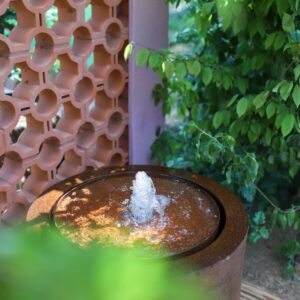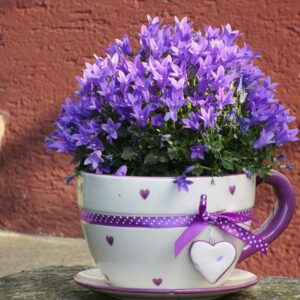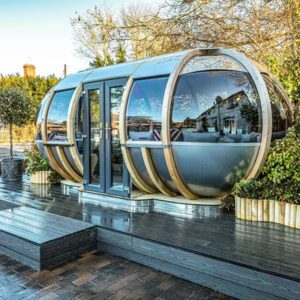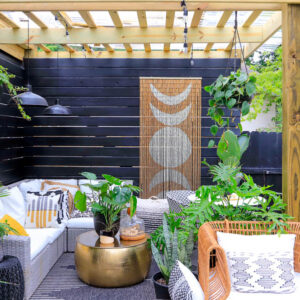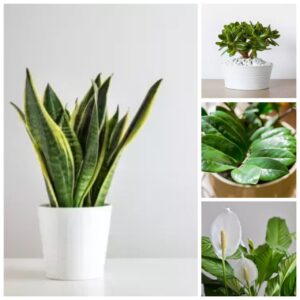Plant Attractive Varieties
Some vegetables, like rainbow Swiss chard, are too beautiful to be confined to the vegetable garden. Show them off by making them focal points in your garden.
This rainbow Swiss chard was recently planted in these strawberry pots, where they will fill out the space. New leaves will fill in where old leaves are harvested, keeping the plants fresh looking and lush.
Use Hanging Planters
There is no gardening rule that says hanging baskets have to be flowers. Most vegetables will work in hanging planters, too. You may even get a better yield, due in part to the heat that is being reflected back off the wall.
You can use any type of container you like, from old buckets to recycled soda bottles, and even expensive ceramic bowls. Just remember that the containers will get heavy when they are full of wet soil and fruiting plants. This gardener has hung baskets attached to strong horizontal boards along a wall.
Interplant With Flowers
Many vegetables make attractive bedding plants alongside flowers, especially if they are quick growers and frequently harvested, like lettuce and other salad greens. A shady spot under a tree is the perfect spot to interplant with flowers. Or you could try a row of carrots on the edge around a sunny border.
Rabbits and other wildlife may find your vegetable bed tempting, but if you interplant with companion flowers that have a strong scent or toss in a few onion plants, these will act as a deterrent.
Try Vertical Gardening
Many gardeners know that old, discarded pallets make great compost bins. They also make great vertical gardens. Staple some landscape fabric to the inside of the front of your pallet and the outside of the rear. Fill the whole thing with good potting soil. Then turn the pallet on its side and make slits where you want to insert your plants. If you are going to hang your pallet garden, make sure you have sturdy hooks, because all that soil and wood will make it heavy.
Build Portable Raised Beds
A simple crate is all you need to plant a salad garden that will feed you for weeks. This is a variation on a raised bed garden, but since it’s self-contained, it’s portable. It may be too heavy to lift when full, but if you put wheels on it, you could move it to wherever the sun decides to shine.
You can squeeze a lot into one small garden. Vegetables that are harvested frequently, such as lettuce, carrots, and onions, will be thinned out as you harvest them, so there will not be overcrowding.
Plant a Garden on Shelves
If you have shelves, you can have a garden. You do not need to buy special hangers or spend the weekend digging out a spot in the yard—all you need is a set of shelves and some containers.
Place your collection on your deck or patio just outside your kitchen, and you will find yourself harvesting far more often than if you had to walk out to the garden. You can even bring some of the containers indoors when the weather turns cold. Do not forget to include some herbs, too.
Plant in Raised Garden Beds
A lot of times raised beds are only a few inches off the ground. While that does provide benefits to the plants, like improved drainage and warming the soil earlier in spring, you can give the gardener another benefit if you raise the bed even higher: less bending.
Lifting the planting beds to waist height, like the three weathered troughs running through this colorful garden, means very little bending and far fewer wildlife problems that would otherwise need additional fencing.
Grow in Greenhouses
Gardening in a greenhouse will not only provide fresh vegetables year-round, but you can also pull up a chair and literally watch the plants grow.
This greenhouse provides a view of the garden outside as well as the sheltered vegetables and flowers growing undercover. It is a great place to set up an office while you keep tabs on how everything is growing.
Plant a Permaculture Garden
If you are drawn toward sustainability, look into creating a permaculture garden. This type of garden tries to duplicate the layering found in natural systems and forests. There are upper story trees, climbers, perennial vegetables, root crops, and self-sowers that intermingle, creating your own personal foraging garden.
It takes some effort to create a working permaculture garden, but it will require much less maintenance than traditional vegetable gardens once it gets going.
Design a Container Garden
Getty Images/ChiccoDodiFC
You can grow just about any vegetable in containers. This can be a very creative and ornamental way to design a vegetable garden. Virtually any container will do, as long as it has good drainage.
Containers can be moved about to take full advantage of the sun. You can plant one type of vegetable per container or mix things up. A downside is that the soil in containers tends to dry out quickly and you may need to water it every day.
Companion Plant Different Varieties
Getty Images/gerdtromm
When you’re growing multiple vegetables within a garden, you’ll want to keep in mind companion plants, meaning planting vegetables that grow well together. Companion planting involves growing plants that will have the same light and water requirements, and they’ll mutually benefit each other as they grow.
Examples include asparagus and petunias, eggplant and marigold, or winter squash and nasturtium.
Grow On Your Fence
Getty Images/ANITA BLAKER
If you have a fence, then you have the perfect spot to plant vegetables or herbs without taking up ground space. Build a planter on your fence or hang boxes from your fence. This keeps plants out of the reach of rabbits and gives them more undisturbed access to sunlight.
Try Small Backyard Solutions
Getty Images/simonkr
A small backyard shouldn’t prevent you from having a garden full of delicious vegetables to harvest. Try succession planting, where you plant vegetables strategically so that there is continuously something new ready to be harvested.
Or try planting smaller, more compact varieties of vegetables to make the most of your small space.
Install Window Boxes
Getty Images/Marina Herrmann
When you need to utilize every square inch in a small space or if you want to add some greenery and color to you home, look to window boxes. These classic gardening vessels aren’t just for flowers. You can use them on the bright side of your home for sun-loving veggies or plant herbs that you want easy access to right outside your kitchen window.
Use Vegetables as Landscaping
Getty Images/Philippe S. Giraud
Rather than interplanting ornamental flowers and vegetables, try planting all vegetables and other edible plants to maximize functional garden space. In this garden, lettuce serves as both the height and edging in the landscaping design. Marigolds are used to add color, but they’re also one of the most popular edible flowers.
Make a Balcony Garden
Getty Images/Westend61
If you have a balcony, then you have room to design a vegetable garden. Combine a container garden with shade tolerant vegetables and you’ll find that you can have a delicious array of veggies, even with your small space.
Build a Ladder Garden
Getty Images/Westend61
Using a ladder to build a vertical garden helps make the most of your space. Grab an old ladder, a few pots, and plant a container garden that is as functional and space efficient as it is charming.
Plant a Traditional Garden
Getty Images/beekeepx
Planting vegetables in rows, sectioned off based on the type of plant, is the traditional way to grow a vegetable garden, and it’s still a favorite of gardeners. It makes for a classic look, like something straight out of a cottage garden, and it’s one of the most efficient ways to grow and harvest plants.
Trellis Your Plants
Getty Images/Joe_Potato
Growing vegetables on a trellis gives you more room to let vines and climbing plants spread. It also adds a timeless, charming look to your garden that is as pretty as it is practical. This is a particularly good idea in gardens where you’re trying to save space and maximize vertical growing techniques.
Style a Plant Wall
Getty Images/boonsom
A plant wall is stylish and functional way to grow a vegetable garden. From letting them climb along the wall to mounting small containers all over a sunny surface, planting a wall of vegetables lets you make the most of a petite patio or small backyard.
Use Unconventional Containers
Getty Images/Binnerstam
You don’t need to go out and buy all new terracotta pots or invest in raised bed planters just to have a vegetable garden. You can think outside the box with the planters that you use, including stainless steel tubs, burlap planting bags, stock tanks, and large tupperware containers.
Try Patio Raised Beds
Getty Images/AKodisinghe
Even if you don’t have a large yard with a dedicated garden space, you can still use raised beds to make gardening physically easier and keep your plants away from hungry rabbits and other small animals. Try raised beds both as decor and functional gardening vessels on a patio or porch.
Add Garden Borders and Paths
Getty Images/Westend61
The round shape and vibrant colors of various lettuces and other leafy greens make them a wonderful option to use as practical garden borders and paths. Use them as edging around a garden bed.
Viewed using Just Read
:max_bytes(150000):strip_icc():format(webp)/Strawberry-Pot-Chard-5a44d0c013f1290037ee5b0b.jpg)
:max_bytes(150000):strip_icc():format(webp)/Wall-7742910440_40bd1bef8d_k-5a44c47f0d327a003762b88a.jpg)
:max_bytes(150000):strip_icc():format(webp)/Kale-Edible-Landscaping-5a4fe737beba330037d7d0bc.jpg)
:max_bytes(150000):strip_icc():format(webp)/Pallettes-5958283274_ab9da6e93a_o-5a44c6d347c2660036b11098.jpg)
:max_bytes(150000):strip_icc():format(webp)/Crate-26769585834_bd6f27d937_k-5a44c555e258f80036b8b412.jpg)
:max_bytes(150000):strip_icc():format(webp)/Containers-4063159933_fab910e6ff_o-5a44cef5c7822d003745f6cf.jpg)
:max_bytes(150000):strip_icc():format(webp)/Opening-GettyImages-503353171-5a32efd94e4f7d003ac37820.jpg)
:max_bytes(150000):strip_icc():format(webp)/Vegetables-in-Greenhouse-5a4fe6adc7822d0037b08b9a.jpg)
:max_bytes(150000):strip_icc():format(webp)/Perma-3632204327_20e1ebdc02_o1-5a44d8b813f1290037ef7bf1.jpg)
:max_bytes(150000):strip_icc():format(webp)/spruce-vegetablegardenideas-ChiccoDodiFC-fa5621be19b24502b4606ba5853873fa.jpg)
:max_bytes(150000):strip_icc():format(webp)/spruce-vegetablegardenideas-gerdtromm-9d65f15bef104749bedb99dbcd5878fd.jpg)
:max_bytes(150000):strip_icc():format(webp)/spruce-vegetablegardenideas-ANITABLAKER-eb016cd978ea471e96dda59ae9350be9.jpg)
:max_bytes(150000):strip_icc():format(webp)/spruce-vegetablegardenideas-simonkr-7ee7b75ae43f4217bc40c4f7d204bc79.jpg)
:max_bytes(150000):strip_icc():format(webp)/spruce-vegetablegardenideas-MarinaHerrmann-05c503112bcb42af995de6c979a62e96.jpg)
:max_bytes(150000):strip_icc():format(webp)/spruce-vegetablegardenideas-PhilippeS.Giraud-56d32d2dddd84ac4b6471acec01e8f62.jpg)
:max_bytes(150000):strip_icc():format(webp)/spruce-vegetablegardenideas-Westend61-bbb534be2abd48d787de3b3afda6a352.jpg)
:max_bytes(150000):strip_icc():format(webp)/spruce-vegetablegardenideas-laddergarden-118769767e2e4ee2ade19173a8f075ed.jpg)
:max_bytes(150000):strip_icc():format(webp)/spruce-vegetablegardenideas-traditionalgarden-fa61d77d2d9c41b2b6e4f6b01269c894.jpg)
:max_bytes(150000):strip_icc():format(webp)/spruce-vegetablegarden-Joe_Potato-6ccc2a7c87f34a8f92cd67dd8b153c74.jpg)
:max_bytes(150000):strip_icc():format(webp)/spruce-vegetablegardenideas-boonsom-19990f263a374c40b48403235df6084a.jpg)
:max_bytes(150000):strip_icc():format(webp)/spruce-vegetablegardenideas-Binnerstam-bc21208ee45d42d09735e8ae628c70b7.jpg)
:max_bytes(150000):strip_icc():format(webp)/spruce-vegetablegardenideas-AKodisinghe-0d43a9145c264499835b4130bd58e337.jpg)
:max_bytes(150000):strip_icc():format(webp)/spruce-vegetablegardenideas-Westend611-a73704b44af14f9babbc7e404a38a8e7.jpg)

